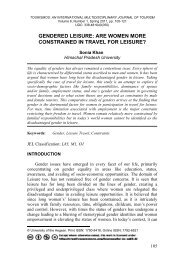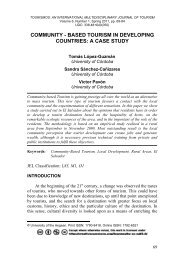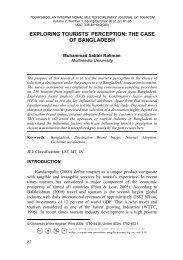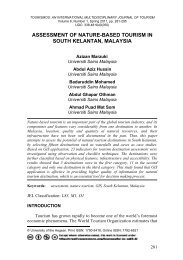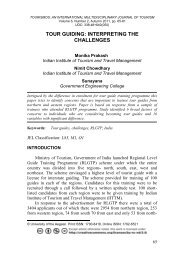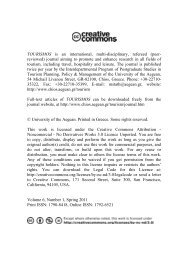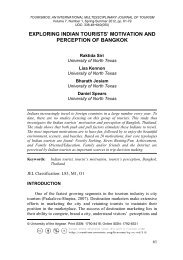ECONOMIC POTENTIAL OF TOURISM : A CASE STUDY OF AGRA
ECONOMIC POTENTIAL OF TOURISM : A CASE STUDY OF AGRA
ECONOMIC POTENTIAL OF TOURISM : A CASE STUDY OF AGRA
Create successful ePaper yourself
Turn your PDF publications into a flip-book with our unique Google optimized e-Paper software.
<strong>TOURISM</strong>OS: AN INTERNATIONAL MULTIDISCIPLINARY JOURNAL <strong>OF</strong> <strong>TOURISM</strong><br />
Volume 6, Number 2, Autumn 2011, pp. 139-158<br />
UDC: 338.48+640(050)<br />
this complex, with the river Jamuna behind it. The large garden<br />
contains four reflecting pools dividing it at the center. Each of these four<br />
sections is further subdivided into four sections and then each into yet<br />
another four sections.<br />
Other Monuments within Taj Complex<br />
1. Rauza Saheli<br />
2. The tomb of Sirhindi Begum<br />
3. Fatehpuri Masjid<br />
4. Mumtazabad (Taj Ganj)<br />
Agra Fort<br />
Though Agra is more famous world over as the city of Taj, Agra Fort<br />
is another dimension to the city that attracts tourists in hordes. Built by<br />
Akbar in Red Sandstone when he was through with the consolidation of<br />
his power after accession to power in 1654, Agra Fort worked both as a<br />
military strategic point as well as the royal residence. Many of the palaces<br />
inside the fort were later added by next generations of Mughal Emperors<br />
like Jahangir and Shahjahan.<br />
Built by Akbar in Red Sandstone when he was through with the<br />
consolidation of his power after accession to power in 1654, Agra Fort<br />
worked both as a military strategic point as well as the royal residence.<br />
Many of the palaces inside the fort were later added by next generations<br />
of Mughal Emperors like Jahangir and Shahjahan.<br />
Most of the buildings within the Agra Fort are a mixture of different<br />
architectural styles. The assimilation of these different styles has given<br />
the buildings within the fort a distinctive look. For instance, the Jahangiri<br />
Palace built by Akbar is a good blend of Islamic (Persian) and different<br />
local Hindu styles. Other buildings either have a mixed style or conform<br />
predominantly to the Islamic style. Akbar, king at 14, began consolidating<br />
his empire and, as an assertion of his power built the fort in Agra between<br />
1565 and 1571, coeval with the construction of Humayun's tomb in Delhi.<br />
The Agra fort retains the irregular outline of the demolished mud-wall<br />
fort of the Lodis.<br />
The lofty battlements o the new fort cast its protective shadow over<br />
the far stretching mansions of court that nobles and princes built along the<br />
riverfront. The magnificent towers, bastions and ramparts and majestic<br />
145



